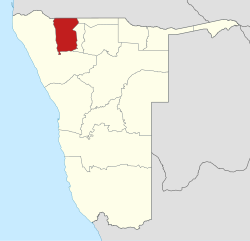Omusati Region
 From Wikipedia - Reading time: 8 min
From Wikipedia - Reading time: 8 min
Omusati Region | |
|---|---|
 Location of the Omusati Region in Namibia | |
| Country | Namibia |
| Capital | Outapi |
| Government | |
| • Governor | Erginus Endjala |
| Area | |
• Total | 26,551 km2 (10,251 sq mi) |
| Population | |
• Total | 316,671 |
| • Density | 12/km2 (31/sq mi) |
| Time zone | UTC+2 (CAT) |
| HDI (2017) | 0.617[4] medium · 9th |
| Website | omusatirc |
Omusati (Ndonga: Mopane, after the dominant tree in the area) is one of the fourteen regions of Namibia, its capital is Outapi. The towns of Okahao, Oshikuku and Ruacana as well as the self-governed village Tsandi are situated in this region. As of 2020[update], Omusati had 148,834 registered voters.[5]
The region is home to the Ruacana Falls, among the largest waterfalls in Africa, and the Omugulugwombashe heritage site, where the Namibian struggle for independence started in 1966.
Geography
[edit]In the north, Omusati borders the Cunene Province of Angola. Domestically, it borders the following regions:
The region got its name from the Mopane tree (omusati: Ndonga: Mopane) which is the dominant species in the region. The Makalani palms decrease rapidly westwards from the border with Oshana region. The change in vegetation type reflects ecological conditions forming a natural boundary between the two regions.
The region is home to the Ruacana Falls. The waterfall is 120 meters (390 ft) high and 700 meters (2,300 ft) wide in full flood and is among the largest waterfalls in Africa, both by volume and width.
Economy and infrastructure
[edit]The northern part of Omusati is far more densely populated than the south, where the grazing is of poor quality and the water is generally saline. This is primarily an agricultural region where mahangu, also known as pearl millet, is successfully grown.[6] A canal carries water from the Ruacana river to Oshakati, passing through Outapi. Water from this canal has been used to irrigate a large, government-run farm at Etunda where crops from maize to watermelon to bananas are grown. The electrical network covers towns including Outapi, Ruacana, Tsandi, Oshikuku, and Okahao.
The region is traversed by a high standard trunk road which provides a direct link to adjacent regions and the rest of the country. Although passenger and freight transport along this route is easy, the rest of this road network, in common with all the communal areas of northern Namibia, is of poor quality. Okahao and Outapi both have small hospitals, and a network of clinics provides basic services.[7]
Only 17% of households in Omusati have access to improved sanitation (toilet facilities).[8] According to the 2012 Namibia Labour Force Survey, unemployment in the Region is 28.9%.[9] Omusati has 274 schools with a total of 86,365 pupils.[10]
Villages
[edit]Politics
[edit]The governor of Omusati since 2015 is Erginus Endjala.[11][12] The region comprises twelve constituencies:
Electorally, Omusati region is consistently dominated by the South West Africa People's Organization (SWAPO). For instance, Omusati voters selected SWAPO with 97.68% of their votes in the 2004 parliamentary election,[13] and again with 98% in the 2014 election.
Regional elections
[edit]In the 2004 regional election for the National Assembly of Namibia, SWAPO won in all constituencies by a landslide. In Anamulenge and Otamanzi no opposition party even nominated a candidate.[14]
The 2015 local and regional elections saw SWAPO obtain 99.4% of the total votes (2010: 99.0)[5] and win uncontested eight of the twelve Omusati constituencies, and two of the five towns.[15] The remaining four constituencies SWAPO won by a landslide, with results ranging from 89% (Ruacana) to 98% (Ogongo).[16] Although SWAPO's support dropped to 86.5% of the total votes in the 2020 regional election, it again won all constituencies by a large margin.[5]
External links
[edit]- Official website Omusati Regional Council
References
[edit]- ^ "Namibia's Population by Region". Election Watch (1). Institute for Public Policy Research: 3. 2013.
- ^ "Omusati 2011 Census Regional Profile" (PDF). Statistics Namibia. Retrieved 10 April 2020.
- ^ "2023 Population & Housing Census Preliminary Report" (PDF). Statistics Namibia.
- ^ "Sub-national HDI - Area Database - Global Data Lab". hdi.globaldatalab.org. Retrieved 2018-09-13.
- ^ a b c "Regional Council 2020 Election Results". Interactive map. Electoral Commission of Namibia. 18 January 2021. Retrieved 23 October 2021.
- ^ "Regions | Namibia". www.namibweb.com. Retrieved 2022-07-07.
- ^ "Map - Omusati Region(Omusati) - MAP[N]ALL.COM". 174.127.109.64. Retrieved 2022-07-07.
- ^ Tjihenuna, Theresia (2 April 2014). "More than 1 million Namibians defecate in open". The Namibian. Archived from the original on 7 April 2014. Retrieved 4 April 2014.
- ^ Duddy, Jo Maré (11 April 2013). "Unemployment rate still alarmingly high". The Namibian. Archived from the original on 14 April 2013.
- ^ Miyanicwe, Clemans; Kahiurika, Ndanki (27 November 2013). "School counsellors overstretched". The Namibian. p. 1.
- ^ "President announces governors". The Namibian. 10 April 2015. Archived from the original on 14 April 2015. Retrieved 14 April 2015.
- ^ "Know your Governors". New Era. 22 August 2022.
- ^ Election Update 2004 Archived 2008-12-03 at the Wayback Machine Namibia
- ^ "Electoral Act, 1992: Notification of Result of General Election for Regional Councils" (pdf). Government Gazette of the Republic of Namibia. No. 3366. Government of Namibia. 3 January 2005. p. 6.
- ^ "Opposition parties are mosquitoes, says Kawana". The Namibian. 26 October 2015.
- ^ "Regional Council Election Results 2015". Electoral Commission of Namibia. 3 December 2015. p. 17. Archived from the original on 8 December 2015.
 KSF
KSF